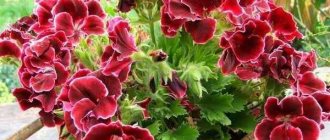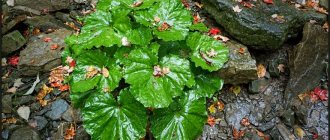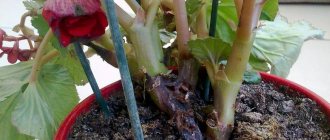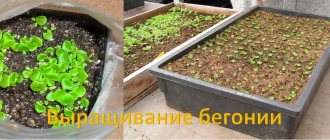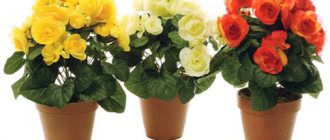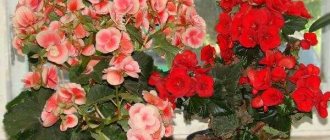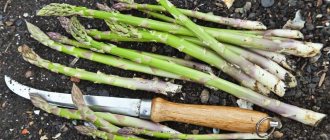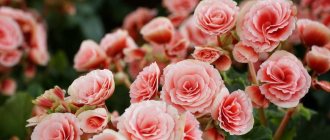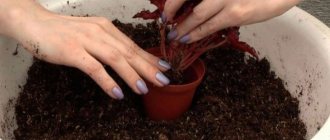Description
The plant is native to Southeast Asia. In London, it attracted attention at an auction of Asian orchids in 1856, and after 3 years three new forms of royal begonia were developed. Experts began to actively engage in the selection of new varieties and forms of plants.
The most popular varieties:
- Dollar Down - low bushes with pointed red leaves and a black border;
Begonia regal Dollar Down
- Escargot (Snail) - bush height up to 30 cm, leaf apparatus is slightly corrugated, at the petiole it twists into a spiral. The leaves are dark olive in color with a silver stripe;
Begonia royal Escargot (Snail)
- Gryphon (Gryphon) is a bush of medium height, the leaf blades are large, two-colored (dark green and pearlescent pink), their edges are beautifully carved.
Begonia royal Gryphon (Griffin)
Preparations containing this plant activate blood circulation and have anti-allergenic, wound-healing and phytoncidal properties. Royal begonia transforms negative energy into positive energy, organizes and harmonizes it, and activates human activity.
Main varieties and their descriptions
Royal begonia has characteristic features that make the flower distinguishable among many indoor plants. Despite the high resistance of the species to all kinds of changes, in recent decades, breeders have created several dozen successful varieties, which brought it enormous popularization.
General characteristics of royal begonia:
| Characteristic | Description |
| Root system | Powerful, creeping, branched. |
| Stem | Fleshy, branched, about 10–20 cm in length. Covered with short reddish bristles. |
| Leaf Shape | Asymmetrical, a characteristic point develops on one side, the edges of the leaflets are jagged. Depending on the species, the shape of the leaf blade can vary from heart-shaped to spiral-shaped or complexly dissected. |
| Leaf color | Most often, green color predominates with various inclusions of scarlet, crimson, lilac, violet and gray shades. The leaf veins have a contrasting red tint. |
| Flower shape | Round, with fan-shaped petals. |
| Flower color | The species blooms in all shades of pink or pale pink. |
Mini Merry Christmas
This begonia is a low plant, reaching a length of 30 cm. This is one of the most variegated varieties among the existing ones. A characteristic feature of the variety is the change in the shade of the leaves from the center to the periphery (from darker to lighter tones).
The central part of the leaf is brown, which towards the edges turns into red-crimson, and then green-white. The lower part of the leaf blade is distinctly sinewy, with large veins, the upper part is velvety, soft to the touch.
Escargot
The Escargot variety is one of the largest among related varieties. This flower reaches a height of 30 cm, while its width can reach 40–45 cm. The surface of the plant is matte and is characterized by numerous villi.
The leaves are the main advantage of the Escargot variety. They are distinguished by a twisted spiral shape, as well as a rich silver-green hue.
Did you know? Royal begonia was first discovered in 1856 in the state of Assam (India).
Dark Mambo
One of the most exotic varieties in plant growing can be called Dark Mambo begonia. Its distinctive feature is the rare, almost black shade of the outer side of the foliage. Sometimes it can be lightened by greenish inclusions, but the leaf always has a fairly dark color.
The inner side of the foliage is red-brown or brown-cherry in color. The plant has a medium size (about 30 cm in height) and a twisted, spiral-shaped leaf blade.
Grifon
Begonia Griffon is a fairly tall plant with a height of about 40–45 cm. This is one of the few varieties that can be successfully grown in pots as a perennial plant and in a flower bed as seasonal vegetation. The leaves of the flower are quite large, divided into separate pointed sections.
Their color is of various green tones, with bright grayish patterns over the entire surface. The flower is unpretentious, so it can be successfully grown even by novice gardeners.
Dollar Down
This variety is famous for its rich and bright red-cherry hue of foliage and the compact size of the bush (the flower does not exceed 20–25 cm in height). The edges of the leaves have a dark, almost black border, which gives them a special contrast.
The shape of the leaf blade is often asymmetrical, fan-shaped, its size smoothly increases from the center to the outer borders.
Did you know? Begonias were named after the governor of Haiti, Michel Begon, who, being a lover of exotic flora, donated a lot of money to expeditions to India to search for new plants.
How to care for royal begonia at home?
The soil substrate must have a slightly acidic reaction. The place where the flowerpot will be placed should be well lit with diffused light. It is necessary to water the plant abundantly, but do not allow stagnation of moisture. You also need to monitor air humidity.
The bush grows and develops well at temperatures of +16...+24°C.
The plant is planted at 4 weeks (when grown from seeds). The pot must be spacious, have drainage holes and a tray.
The bush needs to be replanted every 3-4 years. It is better to do this in the spring, since at this time the plant adapts best. For transplantation, select a pot with a larger diameter than the previous one, but not very deep.
In order to form the correct shape, it is necessary to pinch the bush. Early in the spring, when new shoots begin to grow, their tops are pinched (distance from the top of the shoot is 1 cm).
If the plant is affected by the disease, you need to remove the affected parts with a sharp, disinfected knife. The cut areas must be sprinkled with activated carbon powder.
In winter, royal begonia should be placed in a room with a temperature no higher than 15.5°C. You should be careful about watering - do not overfill or underwater.
How to make it bloom?
Experienced gardeners manage to achieve flowering within 6-12 months. To do this, you must adhere to a number of rules:
- Trim all female flowers of young begonias;
- Fertilize the plant 3 times a month;
- Do not apply fertilizers containing nitrogen;
- Trim spent flowers to prolong flowering.
Not all varieties have a pleasant aroma; some do not have it at all. For example, the Bauman variety has a pleasant aroma and has medicinal properties - it helps cleanse the bronchi and helps with problems with the respiratory tract.
At the end of flowering, the plant needs rest. In place of the flowers, small boxes with seeds are formed . The frequency and duration of flowering of the royal begonia depend on the correct care of it and whether pollination occurs.
Diseases and pests: treatment methods
The plant is very sensitive to changes in living conditions and inappropriate care. When the defenses of royal begonia weaken, it can be damaged by pathogenic microorganisms that cause diseases:
- gray rot - brown spots appear on the leaf blades, then they are covered with a gray coating. Such leaves need to be removed and the bush treated with a fungicide solution;
- powdery mildew - leaf blades are coated with a white coating. Remove the affected leaves and treat the bush with a fungicide solution.
Also, a weakened plant can be damaged by insect pests:
- spider mite is a very small insect (0.5 mm), feeds on cell sap, which leads to depletion of the bush. Royal begonia is treated with a soap solution or insecticide solution;
- aphids - feed on cell sap. The bush is treated with tobacco infusion.
Cultivation Errors and Pathogens
The Royal Rex is the most susceptible to rot and mold. Overwatering or residual moisture on the leaves leads to the formation of foci of fungal and bacterial damage. It is very difficult to cure a diseased plant. You can try to save the flower by deliberately drying the surrounding air and treating it with fungicides. Severely affected stems and leaves will have to be cut off.
If rot begins to rise from the root, you will have to destroy the begonia.
Too dry, hot or cold air causes the leaves to begin to lose color and dry out at the edges. Once the microclimate is restored, the plant will regain its full strength and beauty.
If it is weakened, parasites may choose it. Spider mites, scale insects, thrips and aphids can leave nothing behind a flower in a matter of days.
To get rid of pests, you need to mechanically remove their accumulations, thoroughly wash the leaves and stems with soapy water and then repeatedly treat them with a specialized insecticide.
How to propagate royal begonia?
You can propagate the plant:
- leaf - a healthy and large leaf blade is divided into parts above the bifurcation of the main veins (every 1.5 cm). Leaf cuttings are placed in a moistened soil substrate and covered with film. The film is lifted daily for ventilation. After 30 days, roots form, and after another month, the first leaves;
- stem cuttings - shoots about 15 cm long with 3 leaves are cut, treated with a growth stimulator, planted deep in a moist soil substrate, covered with a glass container and placed in a warm place. Next, the substrate is ventilated daily and, if necessary, moistened. After a month, the root system is formed;
- seeds - in winter, surface sowing is carried out in a prepared substrate. Then the seeds are sprayed with water from a spray bottle and covered with glass, which is then periodically lifted for ventilation. When sprouts appear, the plants are transferred to a cool, well-lit room (to prevent stretching). After the first pair of leaves appears, the plants are transplanted into separate diving glasses filled with soil substrate. Royal begonia is transplanted into flowerpots in the phase of 5-6 leaves.
The advantages of this propagation method are the preservation of varietal characteristics and qualities of the mother plant.
- children - when replanting, young plants are separated along with the root system and planted in flowerpots filled with substrate;
- by dividing the rhizome - a bush that is at least 5 years old is removed from the flowerpot, the roots are washed, and divided into parts (each must have a bud or shoot). Plant in wide flowerpots, water and place in a bright, warm room.
Reproduction methods
There are several propagation methods for royal begonia:
- Cuttings;
- Using a sheet;
- Seeds;
- Dividing the root.
Each of them has its own nuances, which we will discuss further.
Cuttings
Reproduction by cuttings is possible only from adult plants (from 3 years old) . The procedure is as follows:
- For propagation, choose strong, healthy cuttings 10 cm long. They must be cut with a knife, the lower leaves removed, and the upper ones cut in half.
- Dry the cuttings for 2 hours and treat the cut with Kornevin or Heteroauxin.
- Prepare a substrate consisting of special soil for begonias and river sand.
- Plant the cuttings in a container to a depth of 2 cm, cover with glass or polyethylene.
- Regularly moisten the soil with a sprayer and periodically ventilate the container.
- When the first shoots appear (after 4-5 weeks), remove the protective film.
Leaf
Leaf propagation is suitable for both young and adult royal begonias. The technology is as follows:
- To obtain new plants, select a large, healthy-looking leaf and cut it into several parts so that each of them has a central vein.
- Prepare the soil for planting: mix wet sand and peat in equal proportions.
- Place the pieces of leaf on the surface of the soil at a distance of several centimeters from each other.
- We press the leaves a little deeper into the soil (no deeper than 1 cm) or sprinkle them with a little soil.
- Cover the container with transparent film or glass and place it on the windowsill.
As the soil dries, you will need to moisten it with a sprayer so that it is moderately moist. After the first shoots appear (after 6-8 weeks), the container with plants can be opened slightly.
Seeds
The seed propagation method is considered the most difficult of all, because
requires much more time and attention. For planting, you can choose regular (untreated) or granulated seeds. The latter are much easier to work with, so experienced gardeners often choose them.
Instructions for proper landing are as follows:
- As a general rule, seeds should be planted in early spring. Before planting, they should be soaked in a 1% manganese solution for 30-45 minutes.
- Wash the seeds and plant them in a peat tablet, which must be moistened in advance.
- Each tablet is placed on a tray and covered with cling film or glass on top. To keep the tablet always moist, water is constantly added to the tray.
- After the formation of the first shoots (usually after 2-3 weeks) and the appearance of the 3rd leaf, a dive is performed. The procedure must be repeated 8 weeks after emergence.
- Young plants are planted in separate pots.
To grow royal begonia from seeds, the optimal room temperature should be at least 20-22 degrees.
Dividing the bush
The method is most optimal for adult representatives of this variety who are more than 3 years old. The procedure should be carried out in the spring . The procedure is as follows:
- The flower must be carefully removed from the pot, and then the entire root system must be thoroughly rinsed with cool running water.
- Divide the rhizomes with a sharp knife so that 1-2 buds remain on each part.
- Sprinkle the cuts with charcoal.
- Place the flowers in separate pots and water generously.
To speed up the process, you can use Kornevin or Heteroauxin.
Use in landscape design
To create a welcoming environment, it is best to place the flowerpot in the living room. The plant will attract attention and delight with its appearance all year round. It is very good to use a flowerpot with royal begonia when creating a winter garden. If you place a pot with a plant outdoors in the garden, then only in partial shade.
This regal bush has a lot of fans, because its elaborate, interestingly colored leaves surpass many flowers in beauty. For many people, royal begonia is a favorite plant to grow at home.
Popular varieties
Flower growers have long had favorites among varieties. These varieties are particularly decorative and are perfectly adapted to life in a city apartment.
| Species name | Character traits |
| Begonia Bauer | A tuberous variety that must be removed from the ground for the winter. A low, up to 25 cm, plant with an erect stem and large asymmetrical leaves. Flowers come in all shades from red to white. |
| Begonia naked | Long creeping trunks with rooting at nodes. The foliage is medium-sized, ovoid in shape. The inflorescences are small, racemose. Popular with winter garden owners. |
| Begonia Arthur Mallet | A drooping long stem with light green rounded leaves with contrasting burgundy or crimson spots at the petiole. A common hybrid variety. |
| Begonia rich | A perennial plant with a short thick stem. Large egg-shaped leaves combine shades from light olive to silver. The flowers are small, creamy white. |
It is better to choose varieties in accordance with the interior design and individual aesthetic preferences. Photos will help you navigate all the diversity.
Mr. Summer Resident Recommends: Rex Begonia – Doctor for Asthmatics
Thanks to its large, fleshy leaves, Rex perfectly purifies the air. It releases a lot of oxygen and active phytoncides. It was possible to find out that in the room where some varieties are grown, the concentration of Staphylococcus aureus decreases.
It is useful for people with bronchial asthma to have such a flower at home. It has antimicrobial properties, reduces the risk of allergies, and improves immunity.
Humidified air, so necessary for plant health, prevents the appearance of flying dust particles in the air and makes breathing easier.
According to the sign, begonia helps people of creative professions and contributes to a favorable atmosphere at home.
Plant characteristics
Begonia Rex is a herbaceous flower native to northeast India. The short, fleshy stem is covered with red hairs. Plates with long petioles are fixed on the shoots. A creeping powerful root system grows in the upper layers of the soil, gradually moving into the trunk. The height of the bush depends on the variety: there are both miniature specimens (up to 15 cm) and half-meter giants.
The leaves of the royal begonia are the calling card of the species. The unusual zonal coloration of the surface is often accompanied by an asymmetrical shape resembling a heart. The shade varies from bright brown to metallic cherry. The top coating is velvety, with barely noticeable bumps. The lower matte part is cut with red veins.
Blooming royal begonia has no decorative value. Centimeter pink buds are located on long arrows. After fertilization, a capsule with small seeds is formed. In order not to lose the magnificent view, the owners crop the stem before the petals open.
